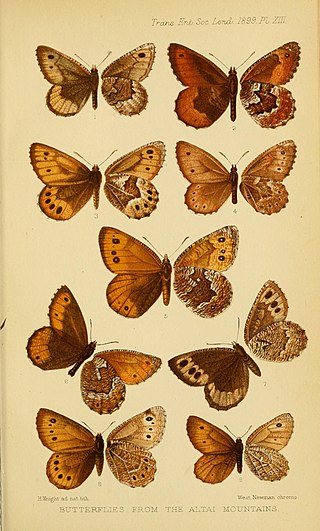
Acossus terebra is a species of moth of the family Cossidae. It is found in Eurasia, including Israel, Turkey, northern Spain, central and southern Europe, southern Sweden, Finland, the Baltic region, Ukraine, the central part of European Russia, the Caucasus, southern Siberia to southern Yakutia, the southern part of the Russian Far East, Korea, Heilongjiang, Jilin and inner Mongolia.

Oeneis magna is a butterfly of the family Nymphalidae. It was described by Ludwig Carl Friedrich Graeser in 1888. It is found from the Altai Mountains to southern Siberia and the Russian Far East, Mongolia, northern China and Korea. The habitat consists of sparse woodlands and mountain tundras.
Catopta is a genus of moths in the family Cossidae.
Catopta eberti is a moth in the family Cossidae. It was described by Franz Daniel in 1964. It is found in Afghanistan.
Catopta griseotincta is a moth in the family Cossidae. It was described by Franz Daniel in 1940. It is found in China in Tibet, northern Yunnan and Sichuan.
Catopta kendevanensis is a moth in the family Cossidae. It was described by Franz Daniel in 1937. It is found in Iran and Afghanistan.
Catopta albimacula is a moth in the family Cossidae. It was described by Staudinger in 1899. It is found in Kyrgyzstan, Kazakhstan, Tajikistan and China.
Catopta albothoracis is a moth in the family Cossidae. It was described by Bao-Zheng Hua, Io Chou, De-Qi Fang and Shu-Liang Chen in 1990. It is found in Sichuan, China.
Catopta cashmirensis is a moth in the family Cossidae. It is found in Kashmir, the north-western Himalayas in India, Nepal, Bhutan and China.
Cossus orientalis is a moth in the family Cossidae. It is found in North Korea and China (Jilin), Russia and Japan.
Catopta birmanopta is a moth in the family Cossidae. It was described by Felix Bryk in 1950. It is found in northern Myanmar.
Catopta danieli is a moth in the family Cossidae. It was described by Harry Kendon Clench in 1958. It is found in Sichuan, China.
Catopta dusii is a moth in the family Cossidae. It was described by Yakovlev, Saldaitis, Kons and Borth in 2013. It is found in China (Sichuan), where it has been recorded at altitudes ranging from 1,150 to 3,000 meters. The habitat consists of mountainous areas.
Catopta grumi is a moth in the family Cossidae. It was described by R.V. Yakovlev in 2009. It is found in China (Quinghai).
Catopta perunovi is a moth in the family Cossidae. It was described by Yakovlev in 2007. It is found in the Altai mountains, the Sayan mountains, north-western Mongolia and central Yakutia.
Catopta sikkimensis is a moth in the family Cossidae. It was described by G.S. Arora in 1965. It is found in Sikkim, India.
Catopta tropicalis is a moth in the family Cossidae. It was described by Yakovlev and Witt in 2009. It is found in northern Vietnam.
The Catoptinae are a subfamily of the family Cossidae.
Eogystia sibirica is a moth in the family Cossidae. It is found in north-eastern Russia, Mongolia and northern China.
Streltzoviella insularis is a moth in the family Cossidae. It is found in China, the southern Russian Far East, Korea and Japan. The habitat consists of nemoral forests at low elevations.

